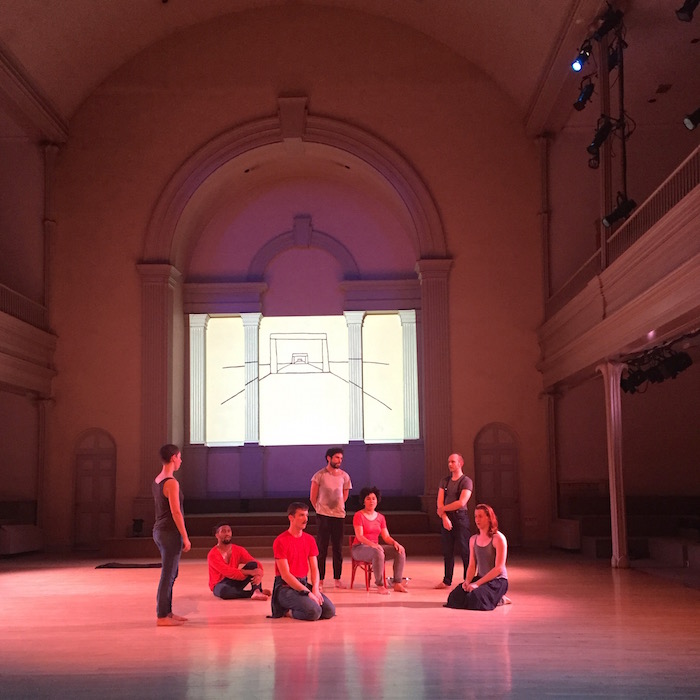An Experiment in Reconstruction…Remembering and Re-imagining the Work of John Bernd
November 1, 2016

Sally
This should be it. Maybe the piece of writing I did yesterday I’ve enclosed, and that really says it all. In rehearsal. a wonderful, blessed, and lucky time. When all of a sudden I thought that it was possible, all the ideas, all my life, of fitting in, that I could see it as possible. And I was speaking and I was moving and I was singing and I was dancing and I started laughing at one point. Just started laughing. And I wrote:
I am either going crazy
or about to die
or about to be born-November 6, 1981
From a draft of a letter John Bernd wrote to Sally Banes (It’s unknown if this letter was sent or not).
Welcome to an experiment in reconstruction; a remembering and re-imagining of the work of John Bernd.
John Bernd is the reason for the Platform 2016: Lost and Found. From the late 1970’s throughout the 80’s to his untimely death at the age of 35 in 1988 he relentlessly created a body of work that was singular in its vision and force. From reading his words it is clear that his drive was a combination of careerist ambition and spiritual mission. He was a key figure of the East Village dance scene. He was one of the first artists to deal explicitly with gay themes, and then as a consequence of his diagnosis, AIDS. He worked interdisciplinarily, and worked with an extraordinary array of dance artists who would go on to make some of the most interesting work in New York.
In order to do a true reconstruction of John Bernd’s work we would need a time machine to bring you back to the way the East Village looked, sounded and smelled in the 80’s. Before 2nd Ave Deli became Chase Bank. Before the Tunnel Bar became a hardware store and the Saint Mark’s Baths became a video store and now a Karaoke Bar. Back to when the raw and immediate aesthetic of the work of that time was fed by the weekly Open Movement sessions at PS122, where John Bernd met Ishmael Houston-Jones, Yvonne Meier, Fred Holland, Stephanie Skura and Jennifer Monson. Where they all danced together and influenced each other and fell in love and made shows together. And most importantly, we would need to bring you to that imperiled era when people died one after the other in the plague era of AIDS in New York City and friends became each other’s patient advocates, caregivers, and eulogists.
There are so many pieces we could have made. John Bernd’s work ranged from unison phrases rooted in his modern dance studies to wild improvisations performed by the very best of the era. He filled his pieces with ebullient physicality, evocative tableaus and performance art gestures of healing and cleansing. Certain material persisted from piece to piece. The projections of his line drawings, which increasingly became fixated on the image of a temple, made their way into several pieces. The triplet stomping was a recurring movement motif, his personal folk dance. And then of course the small red chair, which appears in almost all of his pieces. As he wrote in a letter to Sally Banes “At home. That’s where it begins. At home, you’re sitting in your chair just sitting.”
Drawing on the influence of his mentor Meredith Monk, whom he worked and performed with in the late 70s, he composed music and sang his plaintive songs and wrote passionately and drew obsessively and danced, danced, danced. He loved to dance. And he was compelled to make his work. He swept floors at PS122 in the early mornings so that he could get free rehearsal space. In some cases he performed just days out of the hospital. In his last piece Two On the Loose he tells a story of trying to get rehearsal space in the hospital so that he can work on the piece with Jennifer Monson: “I kept looking for a place I could rehearse. That just always became my project. It still is my project.” He was planning new projects and strategizing potential tours right up until he died.
We have created a re-imagining of Bernd’s work. By taking sections of different pieces and putting them together in new ways, we want to highlight the range of what he made and what he was interested in as well as create a contemporary reflection on his work based on our relationships to it. Ishmael danced in all three parts of Bernd’s Lost and Found series and shared a close friendship with him. Miguel only learned about Bernd’s work through this process and was shocked to discover such a direct ancestor to the elements and concerns in his own work. Nick Hallett has taken John’s music and brought it into conversation with today.
We strongly encourage you to research Bernd’s work. Please go to the Performing Arts Library at Lincoln Center and look up the documentation that exists. Please read the ‘zine – reprinted in the Lost and Found Catalogue – that his friends put together ten years after his death. Please continue to seek out the work of other artists and ancestors whose names never entered the canon. There is more work to be done.
Thank you
Miguel Gutierrez and Ishmael Houston-Jones
Variations on Themes from Lost and Found: Scenes from a Life and other works by John Bernd premieres November 3-5 at Danspace Project.
